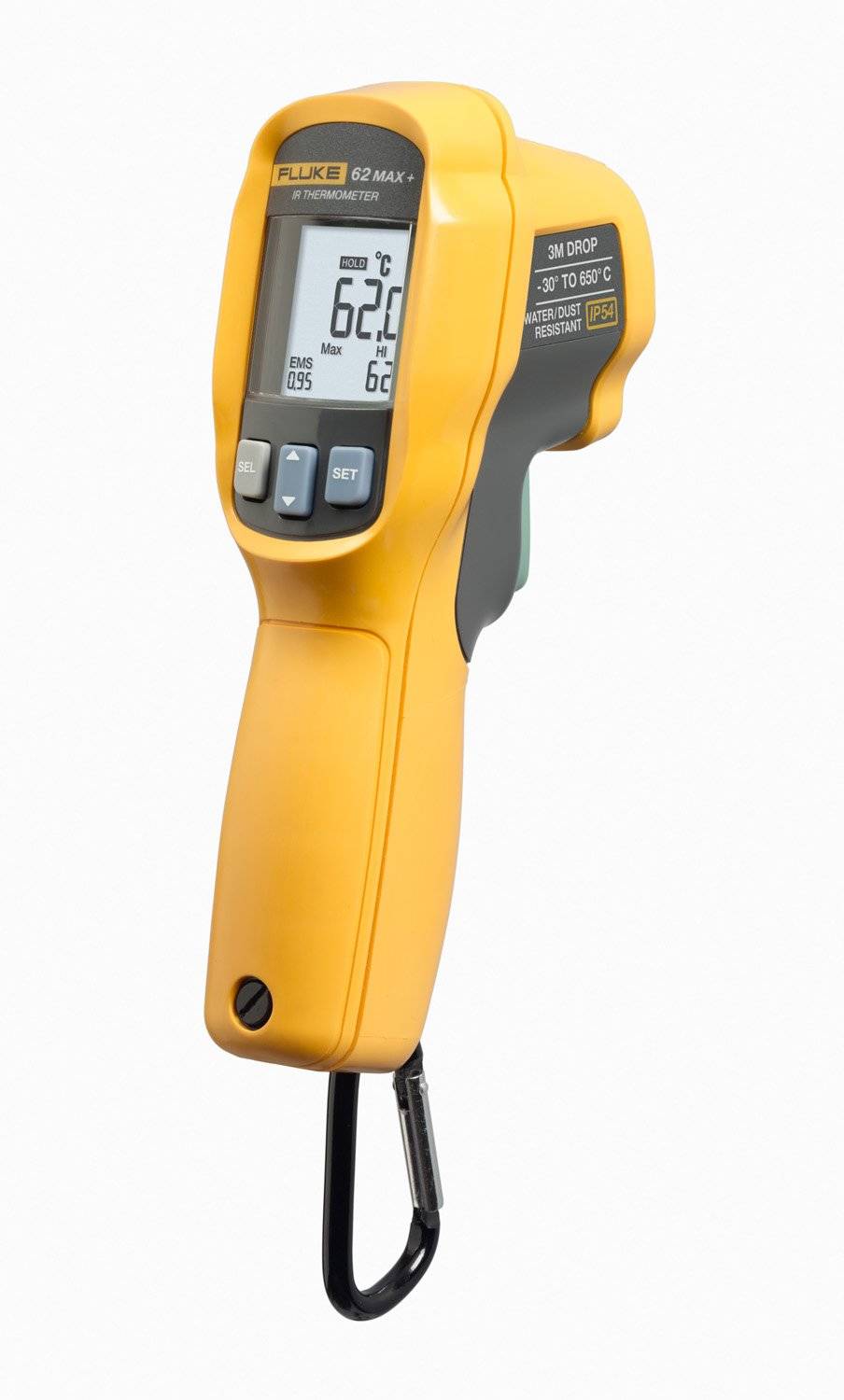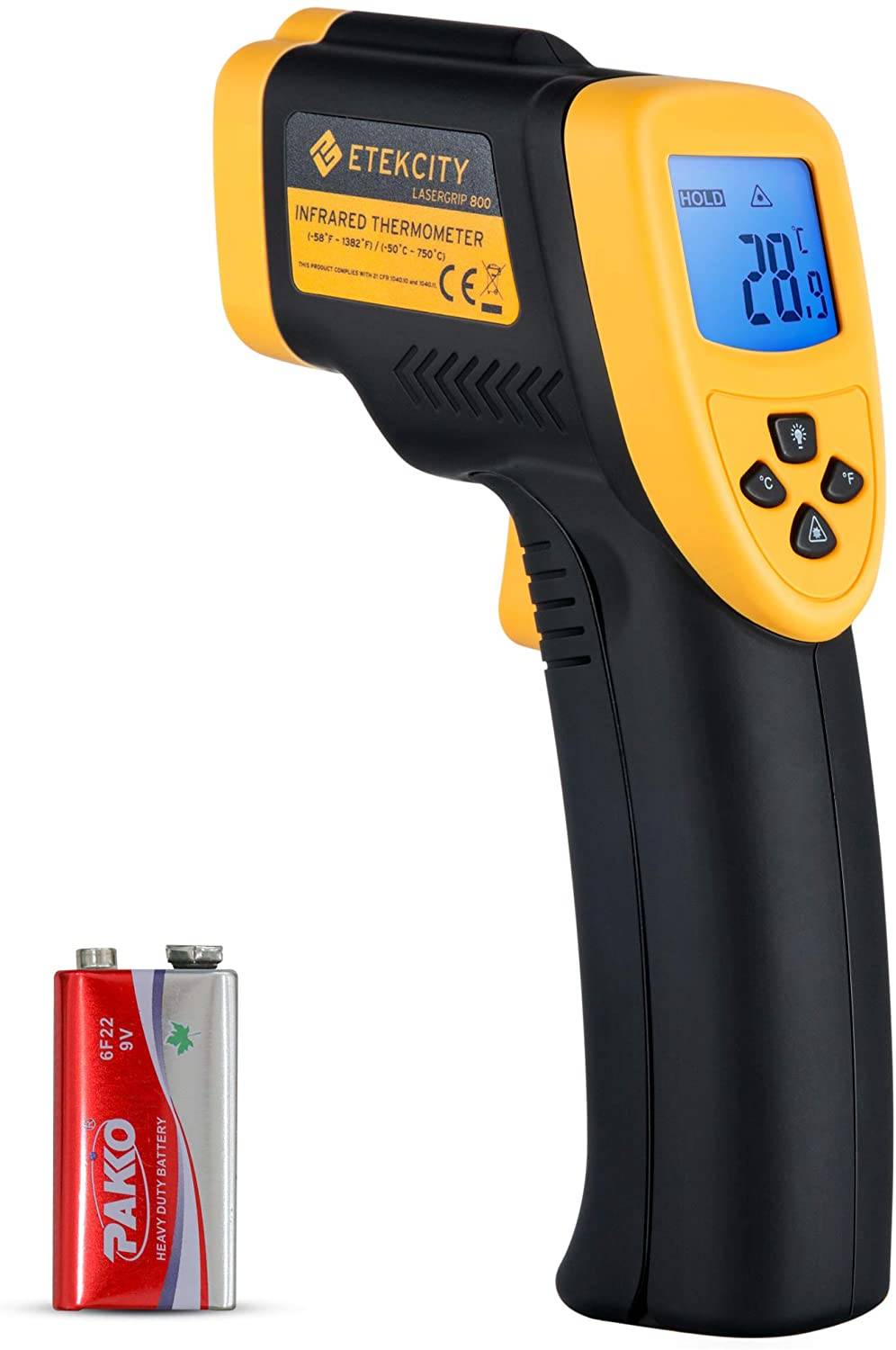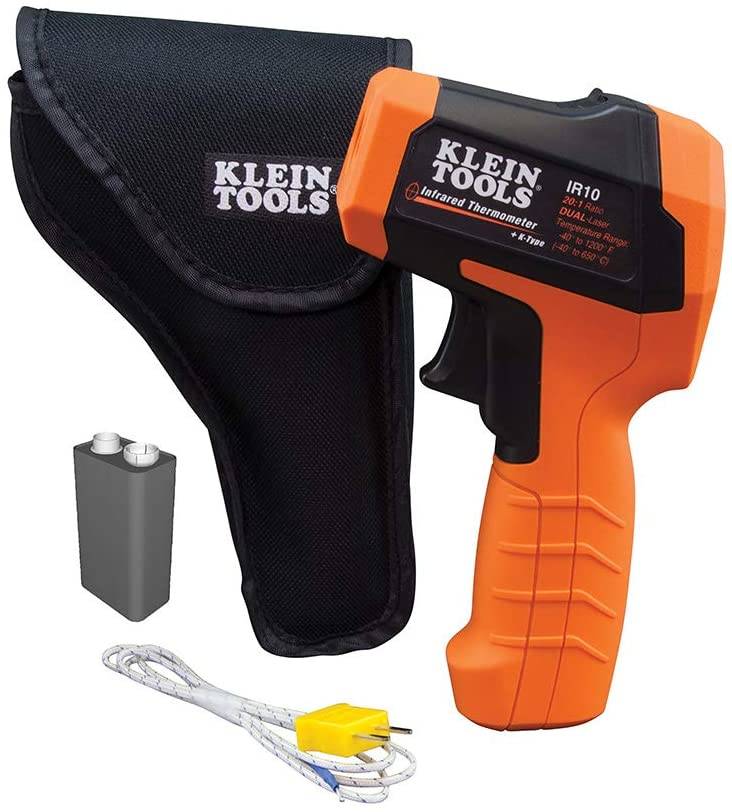The Best Infrared Thermometers For Cooking
We know what you’re probably thinking right now. Infrared thermometers?! For cooking?! Isn’t that going a little overkill? We get it. Obviously this isn’t exactly a conventional cooking tool. In fact, we assume most of you would prefer to use your old faithful traditional thermometers. However, for those interested in expanding the technology in their kitchen and getting accurate temperature readouts from a distance, an infrared thermometer is about to become your best friend.
You see, not only are these handy little handheld devices useful in times of social distancing, they can also be the best friend of home chefs. This is an ideal way to test the temperature of a pizza oven, BBQ, or even food from a safe distance. Sure, it will feel a little strange at first. You’ll feel like you are testing your food for speeding. However, the practical applications will become clear and soon you’ll feel like you’re far more in control of your heat than ever before.
The only question is which infrared thermometer is right for your personal cooking needs. There are so many options out there and if you’re coming into this little pocket of the thermometer industry without any experience, it can seem overwhelming. However, fear not! Nothing about this world is as tricky as it seems. These are products designed to make your life easier, after all.
So, which infrared thermometer is the right one for you? Good news, you’ve come to the right place to find out. Below you’ll find our curated list of the best infrared thermometers on the market. Below that, you’ll find a buying guide to walk you through all of the important things to look out for in the exciting world of infrared thermometers. In other words, by the end of this article you should feel confident to go out and get your family the infrared thermometer that you all deserve.
Best Overall Infrared Thermometer — Fluke 62
If you’re looking for an infrared thermometer that’s accurate, affordable, and durable, look no further than the Fluke 62. Are there more elite infrared thermometers on the market? Sure, but not for anything close to this price. The Fluke 62 has a temperature range between zero and 932 degrees Fahrenheit and can gage temperatures within a 1.5 degree accuracy. Unlike some other options on this list, the Fluke 62 wasn’t designed specifically for cooking. However, as a result that means that it’s designed to hold up against the physical challenges of an industrial setting and slip into your pocket.
Pros
- Pocket sized.
- Affordable
- Accurate within 1.5 degrees.
- Long battery life.
Cons
- Not designed for cooking and therefore not as versatile in the kitchen as some other options.
Best Entry-level Infrared Thermometer — Elekcity Lasergrip 744
Affordable and functional, The Elekcity Lasergrip 800 is the perfect way to start your journey into the wonderful world of infrared thermometers. Solidly built out of plastic and hard rubber, this is a durable tool that’s built to last. It’s powered by a single 9-volt batter (that’s even included!) and automatically powers off after 15 minutes of inactivity. So, this is an infrared thermometer that will cover all of your possible thermometer cooking needs and last you quite a while until you are ready to upgrade. Thanks to laser technology and fast temperature readouts with 3.5 degree accuracy, it’s hard not to fall in love with this thermometer.
Pros
- Energy Efficient.
- Built In backlit LCD screen.
- Affordable
Cons
- Accuracy only falls within 3.5 degrees.
- Can’t read temperatures height than 716 degrees Fahrenheit.
Best Adjustable Infrared Thermometer — Klein Tools IR10
Most infrared thermometers can only monitor surface level IR from a single emissivity level. So for example, stainless steel pans would not be compatible. With an infrared thermometer like the Flein Tools IR10, you can adjust that emissivity level and suddenly be able to use the product in so many more different settings. Beyond that the machine has about the same level of durability and accuracy as the previously discussed models. However, the adjustable emissivity can make a huge difference for some users. It will also make a huge difference in the price though.
Pros
- Adjustable Emissivity.
- Built In backlit LCD screen.
- Accurate readouts.
Cons
- Expensive
Best Kitchen-Focused Infrared Thermometer — Taylor Precision Products Splash Proof Dual Temperature Infrared/Thermocouple Thermometer
Finally, if you want a one-stop shop thermometer that will cover any possible temperature related need in your kitchen, then you’ll want to seek out the Taylor Precision Products Splash Proof Dual Temperature Infrared/Thermocouple Thermometer. Not only does this little beauty have an infrared thermometer that can measure between 67 and 482 degrees Fahrenheit, you’ll also get a more traditional meat thermometer built right in. That easily makes this the most versatile thermometer to have in your kitchen. The only catch is that this machine is obviously expensive and isn’t quite as versatile or accurate as some of the other infrared thermometers on this list. Whether or not this is the right infrared thermometer for you comes entirely down to your needs. If you never plan on using this machine outside of your kitchen or BBQ, this might be the perfect option. If you have other uses for your infrared thermometer or require more precise readouts, look elsewhere.
Pros
- Durable (even waterproof).
- Doubles as a more traditional meat thermometer.
- Built In backlit LCD screen.
- Long battery life.
Cons
- Fairly low temperature range.
- Designed only for kitchen use.
Things To Look Out For
Here are some things to consider when choosing which infrared thermometer is right for you.
Accuracy
While infrared thermometers are certainly useful devices in the kitchen or by the barbeque, most of these machines weren’t specifically designed for that purpose. So, while the highest end possible thermometers offer the greatest possible accuracy of measurement, we’re talking about a difference of only a few degrees accuracy versus the lower end models. That level of accuracy can be vital in a laboratory or factory setting, but when it comes to cooking, it’s rare that being off by a degree or two (or even a fraction of a degree) will make much of a difference in your cooking. So don’t get hung up on this particular quality while infrared thermometer shopping.
Infrared Thermometer Use
This is important. While infrared thermometers are the most expensive and shiniest thermometers on the market, it’s important to make sure that you know what they can be used for. These machines only take surface level temperature. For example, if you want to check the interior temperature of a turkey or steak to see if it’s done, you’ll need a more traditional thermometer. Infrared thermometers are designed for a specific purpose and only have certain applications for cooking. So before investing in one of these items, it’s important to know what those uses are and whether or not that suits your cooking and thermometer needs.
Emissivity
This is a tricky concept to wrap your head around, but an important one for anyone buying an infrared thermometer. Emissivity refers to the level at which certain substances emit thermal energy. Because of this, certain substances and kitchen items will not respond well to infrared thermometers. Stainless steal pans, for example. will not give accurate readings. It is possible to get infrared thermometers with variable emissivity settings. However, this will still require research to know how and when to change this setting. So keep this in mind when choosing your infrared thermometer.
Lens
There are infrared thermometers made with three different lens options. Each has their own advantages or disadvantages. The first is an infrared thermometer with no lens. These tend to be the smallest and least expensive options, however they also need to be very close to any surface to get a reading. On the other end of the spectrum is the Mica lens, which can get an accurate temperature reading from a 20:1 distance to target ratio. That’s impressive. It’s also exclusive only to the most expensive of infrared thermometers and is quite fragile. The mid-range lens option is the plastic fresnel lens, which is more durable than the mica and can read temperatures from an impressive distance, but the temperature range isn’t quite as accurate. So, which type of infrared thermometer lens is right for your home depends entirely on your temperature needs. However, it’s worth taking the time to determine which one works best for you because the lens plays a major role in the price of the infrared thermometer.
Frequently Asked Questions (FAQs)
How does an infrared thermometer work?
Well, there’s a short answer or a very long answer to this question. Rather than subjecting you fine readers to an in depth physics lesson about this technology (which is readily available elsewhere online should you wish to take a deep dive), we’ll explain this technology in the simplest terms possible. Essentially, Infrared thermometers differ from more conventional thermometers in that they make zero direct contact with the surface that they are measuring. Instead, these remarkable machines sense the amount of infrared radiation emanating from the surface. They can accurately predict temperature through this radiation emission of a one foot circle from up to ten feet away. Higher end models use laser to visualize this circle for you, but that likely won’t be a necessary upgrade if you only plan to use this technology for cooking.
How do I use an infrared thermometer?
This is the best and easiest part. All you need to do is point the thermometer, pull the trigger, and read the display. It’s really that easy and will work almost instantaneously. Do you understand the appeal of infrared thermometers yet?!
Why should I use an infrared thermometer over a conventional thermometer?
Not only are infrared thermometers faster and more accurate that more traditional options, they also allow you to take accurate readings of heat from a safe distance and in places conventional thermometers wouldn’t function. Sure, you could burn up your arm while holding a traditional thermometer inside a pizza oven or flaming BBQ, but wouldn’t it be better to get an even more accurate reading from a safe distance?
How accurate are infrared thermometers?
Obviously, this can very between products. However, in general these machines are quite accurate. Even the most basic models have a temperature measurement range from zero to roughly 600 degrees Fahrenheit. You can also expect the accuracy to fall within four degrees. Obviously the higher end models can offer even greater accuracy and range. But even if you’re buying on the budget end of the infrared thermometer spectrum, you can expect a high quality product.
What are the disadvantages of infrared thermometers?
Infrared thermometers can only get the surface temperature of whatever they are pointed at. So you won’t be able to get the temperature of anything that’s within a liquid nor will you be able to take the temperature of the interior of a cut of meat while you’re cooking. Infrared thermometers have many practical applications, however when it comes to cooking these machines should only be used for measuring the temperature of cooking surfaces, not any food that you are preparing. Like most thermometers, these are specialty item for specific types of use and won’t be able to solve all of your temperature related needs.
What is the best way to clean an infrared thermometer?
In order for infrared thermometers to work at their best and most accurate state, they will need to be regularly cleaned. Obviously, with a high tech piece of machinery like this, you aren’t going to want to shove it into your dishwasher alongside your pots and pans. Instead, you’ll want to use a cotton swab or soft cloth that has been dabbed with water (or rubbing alcohol if a deep clean is necessary). Gently use the cloth or swab to wipe the lens clean and then be sure to let the lens fully dry before use.
Are infrared thermometers safe?
It would be a mistake to point this at anyone’s eyes due to the laser technology involved, but other than that there are no safety concerns related to incorporating am infrared thermometer into your cooking.




